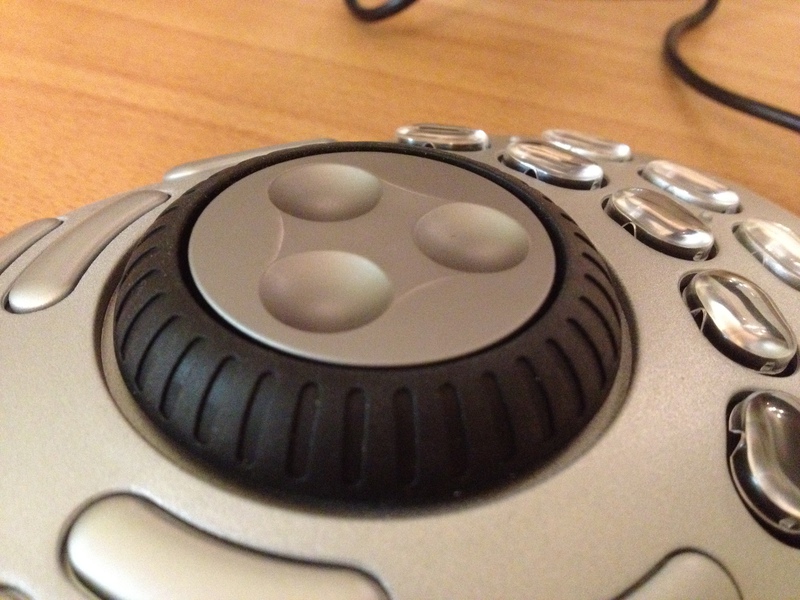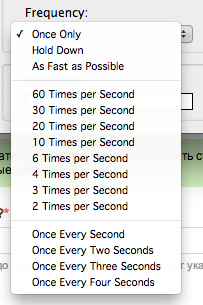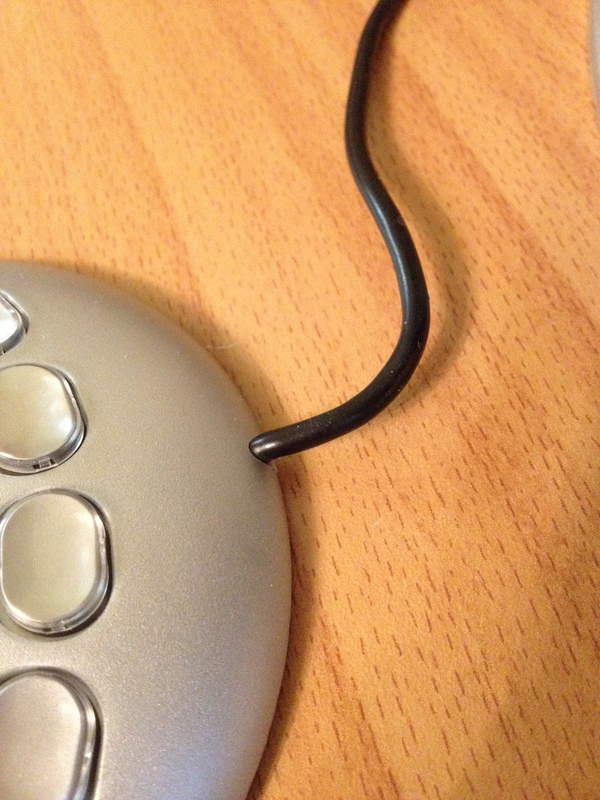Contour Design ShuttlePRO v2 Controller: Overview, Purpose, and First Experience
Good day to all habrazhitel!
Just the day before yesterday, the ShuttlePRO v2 controller came to me . This device will most correctly be called a universal controller. On the official website, the device is described as “ an editing tool that will have you wondering why you even need a keyboard ” ( “ an editing tool that will make you wonder why you need a keyboard at all”). After a couple of days of using the device, I can simultaneously agree with this wording, and I can not. In this topic, I will try to explain why.

Caution, under the cut a lot of pictures and text!
So, the first and main question - why? There are several answers.
The first and main reason is the obvious and rather unpleasant signs of carpal tunnel syndrome that appeared in me . These are sharp pains in the wrists, and numbness of the hands, and several other "nyashki" that are probably familiar to many people who work with the keyboard most of the time. If this happened to you, I don’t need to explain for a long time what it is about. I am professionally involved in video editing and color correction, so most of the time my hands are on the mouse, keyboard or on the Tangent Wave controller . And not always the position of the hands is correct, which as a result has rather unpleasant consequences.
The second reason is the desire to increase productivity and usability. During video editing, 15-20 basic keyboard shortcuts are most often used, and sometimes in order to press them, you have to wring very intricate figures with your fingers, which also do not add convenience and do not increase work speed.
In general, I chose between two models - ShuttlePRO v2 and 3Dconnexion SpacePilot PRO . In the end, the toad took over and I chose a more affordable device.
The device is delivered in an impressive and rigid cardboard box:

However, when unpacking it turned out that the box is “multi-layer” and inside the black “decorative” part there is another box of their durable white cardboard:

The device itself inside the package is fixed quite well, at least mine felt fine after traveling across the Atlantic:

The delivery set is quite “Spartan” - but, on the other hand, the device itself, a set of shortcuts for buttons, manuals, a software disc - what else is needed?

The device is made of high-quality rough plastic. There are no hints of “subsidence” of the case, creaking or backlash during operation:

The device has 15 buttons and a double jog wheel. The button travel is small, but quite clear and tangible. Those. accidental clicks are practically excluded, just like situations like “did I click or didn't click?”. The inside of the jog rotates freely in both directions, has three recesses and is made of soft-touch brushed aluminum, the outside (called Shuttle) is made of rubberized plastic, spring-loaded and has 15 positions (7 in each direction + central position “by default”, into which Shuttle automatically returns as soon as it is released).

In general, the hand on the device rests well and comfortably. Even “blindly” confusing the buttons is absolutely impossible, but for those who want to “peep” the top 9 buttons have transparent caps under which you can insert the shortcuts included in the kit. Half of these labels have standard pictograms or names of the most common actions, the second half is pristine so that the user has the opportunity to print / write their own options on them:

In the best traditions of the inhabitants of the post-Soviet space, without reading the instructions, we unpack and connect to the USB hub in the monitor. III ... nothing is happening. Ok, obviously not enough food. We connect directly to the IIIii computer ... nothing still happens. Getting nervous. We insert the software disc, run the installer, which already explains that after installing firewood and software, a reboot is needed. Fffuh, relieved from the heart.
After a reboot, the layout manager for the controller for some reason did not get into startup. I started it manually, but manually put it into autoload. I don’t know if this glitch specifically got out from me or is it a global “cant” of the manufacturer, the site has nothing to do with the need to launch the dispatcher manually each time, nor can I manually insert it into startup. Anyway. Small trouble.
By default, the layout manager already has a pretty impressive list of ready-made layouts for a wide variety of applications, both designed to work with multimedia, and not:


For many applications, there are several layout options for different versions or even for different operating modes:

At the same time, of course, all the buttons, like both wheels, are fully programmable - you can hang any keyboard key, any key combination, or even any macro on any of them. At the same time, the shuttle-wheel has the ability to program each of the 15 positions separately, and in addition, you can set the gradation (intensity), the action will be performed with a shortness - you can perform the action one-time, or perform it while the shuttle is held in the set position, or perform an action with a certain frequency - from 60 times per second to 1 time in 4 seconds. This makes it possible to fine-tune shuttle to control timeline rewind.

The standard layout for working with Final Cut Pro 7 (my main tool for today) turned out to be completely useless and inconvenient for me, I had to redo almost everything for myself (I see nothing wrong with that, actually). But the result was worth it - video editing using this controller can be called a process even in some ways pleasant.
However, no one is perfect, so I note the obvious disadvantages of the device and work with it. Firstly, the wire at the entrance to the device is clearly unreliable:

The length of the wire is about one and a half meters. In general, it’s enough, but if you use a computer with a system unit and it is far from the workplace, there may not be enough lace.
Secondly, not enough buttons. Still, video editing, in spite of all its “technicality”, is a creative process in any case, so there are a lot of necessary options. This controller helps to speed up the work, but you still have to “jump” to the keyboard, all the hot keys with 15 buttons will not fit, even with macros. The work is accelerated, but the keyboard cannot be completely abandoned. Well, the interface for configuring hot keys gives the last century and generally mothballs:

So, in the bottom line, we have pros and cons.
Pros :
• Ergonomics (the hand is cool, the response speed pleases)
• Performance (the speed of work grows significantly!)
• Workmanship
• Multi-platform (you can use the same buttons in different programs on different platforms)
• Range of supported programs (very wide by default + you can create your own layout for almost every program)
• Price (for such a device of such quality $ 100 is not money)
Minuses :
• The number of buttons (all the same, you cannot completely abandon the keyboard, even with the simplest installation). I would like another 5-7, and better - 10 buttons, then the work in a bunch of “controller + mouse” is really real, which would really allow to increase the speed.
• Complete set of icons. There is simply no icon that combines “Play” and “Pause”, these are two separate tabs - despite the fact that in the vast majority of programs these two functions have long been combined.
• Interface and functionality of the standard driver - it looks and works as if it was written about 5 years ago, no less.
As a result, I can safely recommend this device to video editors, designers, CG-employees, active users of Photoshop, sound engineers and audio designers, photographers and operators. No matter how unusual this device may look - believe me, it is worth the money and can save you a lot of time!
Just the day before yesterday, the ShuttlePRO v2 controller came to me . This device will most correctly be called a universal controller. On the official website, the device is described as “ an editing tool that will have you wondering why you even need a keyboard ” ( “ an editing tool that will make you wonder why you need a keyboard at all”). After a couple of days of using the device, I can simultaneously agree with this wording, and I can not. In this topic, I will try to explain why.

Caution, under the cut a lot of pictures and text!
So, the first and main question - why? There are several answers.
The first and main reason is the obvious and rather unpleasant signs of carpal tunnel syndrome that appeared in me . These are sharp pains in the wrists, and numbness of the hands, and several other "nyashki" that are probably familiar to many people who work with the keyboard most of the time. If this happened to you, I don’t need to explain for a long time what it is about. I am professionally involved in video editing and color correction, so most of the time my hands are on the mouse, keyboard or on the Tangent Wave controller . And not always the position of the hands is correct, which as a result has rather unpleasant consequences.
The second reason is the desire to increase productivity and usability. During video editing, 15-20 basic keyboard shortcuts are most often used, and sometimes in order to press them, you have to wring very intricate figures with your fingers, which also do not add convenience and do not increase work speed.
In general, I chose between two models - ShuttlePRO v2 and 3Dconnexion SpacePilot PRO . In the end, the toad took over and I chose a more affordable device.
The device is delivered in an impressive and rigid cardboard box:

However, when unpacking it turned out that the box is “multi-layer” and inside the black “decorative” part there is another box of their durable white cardboard:

The device itself inside the package is fixed quite well, at least mine felt fine after traveling across the Atlantic:

The delivery set is quite “Spartan” - but, on the other hand, the device itself, a set of shortcuts for buttons, manuals, a software disc - what else is needed?

The device is made of high-quality rough plastic. There are no hints of “subsidence” of the case, creaking or backlash during operation:

The device has 15 buttons and a double jog wheel. The button travel is small, but quite clear and tangible. Those. accidental clicks are practically excluded, just like situations like “did I click or didn't click?”. The inside of the jog rotates freely in both directions, has three recesses and is made of soft-touch brushed aluminum, the outside (called Shuttle) is made of rubberized plastic, spring-loaded and has 15 positions (7 in each direction + central position “by default”, into which Shuttle automatically returns as soon as it is released).

In general, the hand on the device rests well and comfortably. Even “blindly” confusing the buttons is absolutely impossible, but for those who want to “peep” the top 9 buttons have transparent caps under which you can insert the shortcuts included in the kit. Half of these labels have standard pictograms or names of the most common actions, the second half is pristine so that the user has the opportunity to print / write their own options on them:

In the best traditions of the inhabitants of the post-Soviet space, without reading the instructions, we unpack and connect to the USB hub in the monitor. III ... nothing is happening. Ok, obviously not enough food. We connect directly to the IIIii computer ... nothing still happens. Getting nervous. We insert the software disc, run the installer, which already explains that after installing firewood and software, a reboot is needed. Fffuh, relieved from the heart.
After a reboot, the layout manager for the controller for some reason did not get into startup. I started it manually, but manually put it into autoload. I don’t know if this glitch specifically got out from me or is it a global “cant” of the manufacturer, the site has nothing to do with the need to launch the dispatcher manually each time, nor can I manually insert it into startup. Anyway. Small trouble.
By default, the layout manager already has a pretty impressive list of ready-made layouts for a wide variety of applications, both designed to work with multimedia, and not:


For many applications, there are several layout options for different versions or even for different operating modes:

At the same time, of course, all the buttons, like both wheels, are fully programmable - you can hang any keyboard key, any key combination, or even any macro on any of them. At the same time, the shuttle-wheel has the ability to program each of the 15 positions separately, and in addition, you can set the gradation (intensity), the action will be performed with a shortness - you can perform the action one-time, or perform it while the shuttle is held in the set position, or perform an action with a certain frequency - from 60 times per second to 1 time in 4 seconds. This makes it possible to fine-tune shuttle to control timeline rewind.

The standard layout for working with Final Cut Pro 7 (my main tool for today) turned out to be completely useless and inconvenient for me, I had to redo almost everything for myself (I see nothing wrong with that, actually). But the result was worth it - video editing using this controller can be called a process even in some ways pleasant.
However, no one is perfect, so I note the obvious disadvantages of the device and work with it. Firstly, the wire at the entrance to the device is clearly unreliable:

The length of the wire is about one and a half meters. In general, it’s enough, but if you use a computer with a system unit and it is far from the workplace, there may not be enough lace.
Secondly, not enough buttons. Still, video editing, in spite of all its “technicality”, is a creative process in any case, so there are a lot of necessary options. This controller helps to speed up the work, but you still have to “jump” to the keyboard, all the hot keys with 15 buttons will not fit, even with macros. The work is accelerated, but the keyboard cannot be completely abandoned. Well, the interface for configuring hot keys gives the last century and generally mothballs:

So, in the bottom line, we have pros and cons.
Pros :
• Ergonomics (the hand is cool, the response speed pleases)
• Performance (the speed of work grows significantly!)
• Workmanship
• Multi-platform (you can use the same buttons in different programs on different platforms)
• Range of supported programs (very wide by default + you can create your own layout for almost every program)
• Price (for such a device of such quality $ 100 is not money)
Minuses :
• The number of buttons (all the same, you cannot completely abandon the keyboard, even with the simplest installation). I would like another 5-7, and better - 10 buttons, then the work in a bunch of “controller + mouse” is really real, which would really allow to increase the speed.
• Complete set of icons. There is simply no icon that combines “Play” and “Pause”, these are two separate tabs - despite the fact that in the vast majority of programs these two functions have long been combined.
• Interface and functionality of the standard driver - it looks and works as if it was written about 5 years ago, no less.
As a result, I can safely recommend this device to video editors, designers, CG-employees, active users of Photoshop, sound engineers and audio designers, photographers and operators. No matter how unusual this device may look - believe me, it is worth the money and can save you a lot of time!
